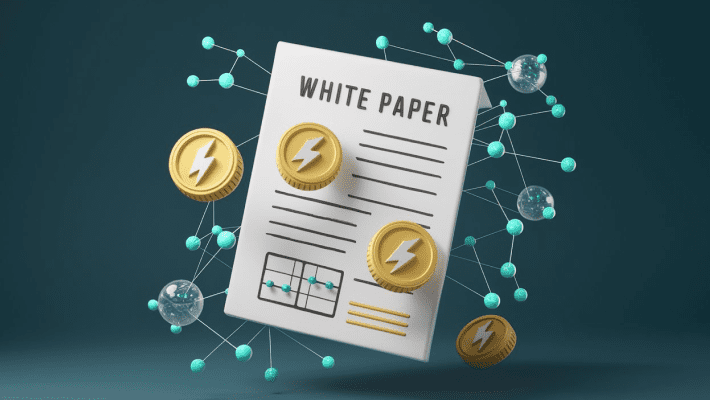How to Read a Crypto Whitepaper
- Bitcoinsguide.org

- Sep 19
- 3 min read
Your Step-by-Step Guide to Evaluating Crypto Projects
Introduction
If you’ve been in the crypto space for a while, you’ve likely heard the phrase:"Do your own research (DYOR)."
One of the most important parts of this research is reading a project’s whitepaper.
But what exactly is a whitepaper — and how do you read one effectively?
In this guide, we’ll break it down step by step so you can confidently evaluate any crypto project.

What Is a Crypto Whitepaper?
A whitepaper is an official document that explains:
✅ What a crypto project is
✅ How it works (technical details)
✅ What problem it aims to solve
✅ How its tokenomics are designed
✅ The project’s roadmap & vision
Think of it as a business plan + technical manual + pitch deck all in one.
👉 In the crypto world, a whitepaper is often one of the first public documents a project releases — especially during ICOs, IDOs, or NFT launches.
Why Reading the Whitepaper Matters
Avoid scams: Many scam projects copy existing ideas or offer vague promises.
Understand value: Can this project realistically solve the problem it targets?
Assess tokenomics: Is the token supply fair? Who controls most of it?
Check team transparency: Are the founders and developers credible?
👉 Reading a whitepaper helps you make informed investment decisions — not just follow hype.
How to Read a Whitepaper — Step by Step
1️⃣ Start With the Abstract
The abstract is usually a 1-paragraph summary.
It should clearly state what the project does and what problem it solves.
Watch out for vague buzzwords like “revolutionary,” “world-changing,” with no concrete explanation.
Questions to ask:
Does this problem actually need a blockchain solution?
Is the goal realistic?
2️⃣ Understand the Problem Statement
This section explains why the project exists.
Look for a clear explanation of the pain point the project addresses.
Red flags:
❌ No clearly defined problem
❌ Vague industry jargon without substance
❌ Overstated claims (“we will replace all banks”)
3️⃣ Examine the Proposed Solution
Here, the whitepaper should outline how the project solves the problem.
What technology is being used?
How does the blockchain component fit in?
Is the solution unique or innovative?
Does the project rely on existing blockchains (Ethereum, Solana) or its own chain?
Tip: Simplicity is often a good sign. If the solution is overly complicated or unclear, be cautious.
4️⃣ Check the Technology Architecture
This is usually the most technical section.
How does the protocol work?
What consensus mechanism is used (Proof of Work, Proof of Stake, etc.)?
How does the network handle scalability and security?
If you’re not a developer:
Focus on whether the whitepaper explains things clearly for a broad audience.
Look for transparency — good projects don’t hide complexity behind marketing
language.
5️⃣ Analyze the Tokenomics
One of the most critical parts!
Key elements to look for:
✅ Total supply of tokens
✅ Distribution plan (team, investors, community)
✅ Vesting schedules
✅ Utility of the token (governance, staking, fees, etc.)
✅ Incentives for early users
Red flags:
❌ Large % of tokens reserved for founders or early investors
❌ No clear token use case
❌ No vesting → team can dump tokens immediately
6️⃣ Review the Roadmap
What milestones has the project already achieved?
What’s planned for the next 6–12 months?
Are the goals realistic and time-bound?
Warning signs:
❌ Roadmap is too vague ("develop ecosystem")
❌ No concrete deliverables or dates
❌ Unrealistic promises (launching mainnet in 1 month)
7️⃣ Research the Team & Partners
Are team members fully disclosed (LinkedIn, past experience)?
Are there credible advisors or partners?
Is there an active GitHub or development repo?
Caution:
Anonymous teams aren’t automatically bad (Bitcoin started that way), but transparency builds trust — especially for new projects.
Bonus Tips
Read Other Analyses
Use resources like Messari, CoinGecko, CoinMarketCap for second opinions.
Join community forums (Reddit, Discord) — but watch out for shilling.
Look for Audits
Has the project been audited by a reputable third party?
Is the audit publicly available?

Know the whitepaper before investing
Conclusion
Reading a whitepaper takes practice — but it’s one of the best ways to protect yourself from hype, scams, and bad investments.
Remember to ask:
✅ Does the project solve a real problem?
✅ Is the solution technically sound?
✅ Are tokenomics fair and transparent?
✅ Is the team credible?
✅ Is the roadmap realistic?
👉 If any of these answers raise doubts — it’s okay to walk away.
In crypto, missing one good project is better than falling for a bad one.



Comments